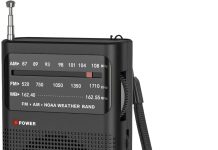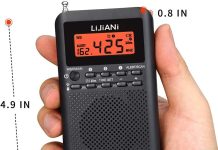Curious about the discrepancy between AM and FM emergency weather radios? Let us shed some light on this commonly misunderstood topic. As we navigate the world of emergency preparedness, understanding the distinctive features of AM and FM radios becomes increasingly important. While both platforms offer crucial access to weather updates, their varying capabilities and functionalities can make all the difference when it comes to staying informed and safe during hazardous situations. So, without further ado, let us unravel the mysteries of AM and FM emergency weather radios and ensure that you are equipped to make the right choice for your emergency preparedness needs.
Review contents
Frequency
AM (Amplitude Modulation)
AM, which stands for Amplitude Modulation, is a type of radio broadcast that uses changes in the amplitude of the carrier wave to convey information. This means that the audio signal is combined with the carrier wave by varying the wave’s height or strength. AM frequencies range from 540 to 1600 kHz, and they are spaced 10 kHz apart. AM signals are typically used for long-distance communication due to their ability to travel over large areas.
FM (Frequency Modulation)
FM, or Frequency Modulation, is another type of radio broadcast that uses variations in the frequency of the carrier wave to transmit information. Instead of changing the amplitude like AM, FM changes the frequency of the wave. FM frequencies range from 88 to 108 MHz. FM signals are known for their high-fidelity audio quality and are commonly used for music-based broadcasts.
Signal Strength
AM: Long Range, Less Quality
One of the significant advantages of AM radio is its ability to cover long distances. AM signals can travel further because they have the advantage of ground wave propagation, which enables the signal to follow the Earth’s curvature. This allows AM radio signals to reach remote areas and listeners in rural locations. However, with this increased range comes a trade-off in audio quality. AM signals tend to have a lower overall audio quality compared to FM broadcasts.
FM: Short Range, Better Quality
While FM signals have a more limited range compared to AM, they offer superior audio quality. FM radio broadcasts provide clearer and more detailed sound because the information is carried in the variation of the frequency. The higher bandwidth available for FM signals allows for a wider dynamic range and better fidelity. FM broadcasts are particularly well-suited for music and high-quality audio content.
Audio Quality
AM: Louder, More Distorted
AM radio broadcasts generally produce louder audio compared to FM. This is because the modulation process in AM emphasizes the amplitude, resulting in a signal that is louder in terms of volume. However, the downside to this increased volume is that AM signals can be more susceptible to noise and distortion. Factors such as electrical interference and atmospheric conditions can further affect the audio quality of AM broadcasts.
FM: Clearer, Less Distorted
FM radio broadcasts, in contrast, offer a clearer and less distorted audio experience. The use of frequency modulation in FM allows for a more detailed reproduction of the original audio signal. As a result, FM broadcasts are less prone to interference and have a better signal-to-noise ratio. This means that FM stations can deliver higher fidelity sound, making them a popular choice for those who prioritize audio quality.
Interference
AM: Less Susceptible, Picks up Electrical Noise
AM radio is known for its resistance to certain types of interference. AM signals are less susceptible to multipath interference, which occurs when signals bounce off buildings or other structures and arrive at the receiver at different times. However, AM broadcasts are more prone to picking up electrical noise, such as static or hum caused by nearby electronic devices. This interference can affect the overall audio quality of AM radio stations.
FM: More Susceptible, Better Rejects Electrical Noise
FM radio broadcasts are more susceptible to multipath interference compared to AM. This interference can cause signal dropouts or fading in areas with obstacles or reflective surfaces. However, FM radio signals are generally better at rejecting electrical noise, which means they are less likely to be affected by static or interference from nearby devices. This makes FM radio a good choice in areas with high levels of electrical interference.
Weather Band
AM: Does NOT Include Weather Band
When it comes to weather band reception, AM radios do not typically include this feature. The weather band is a frequency range reserved for broadcasting weather alerts, emergency information, and other weather-related content. While AM radios are useful for general broadcasting and communication, they do not have the built-in capability to receive weather band signals. This makes them less useful in emergency situations where up-to-date weather information is essential.
FM: Includes Weather Band
FM radios, on the other hand, often include the weather band feature. This allows FM receivers to tune into weather band frequencies and receive alerts from the National Oceanic and Atmospheric Administration (NOAA) and other weather services. With FM radios that include weather band functionality, individuals can stay informed about severe weather conditions, emergency alerts, and other critical updates during hazardous weather events.
Broadcast Range
AM: Longer Elevation Range
Due to the nature of ground wave propagation, AM radio signals have a longer range in terms of elevation. This means that AM signals can travel over hills and other elevated terrain more effectively. The ability to follow the Earth’s curvature enables AM broadcasts to reach listeners in remote areas and even over long distances. This makes AM radio an important means of communication in rural or mountainous regions.
FM: Shorter Elevation Range
FM radio signals, on the other hand, have a shorter range when it comes to elevation. This is because FM broadcasts rely more on line-of-sight propagation. FM signals travel in straight lines and do not readily curve around the Earth’s surface like AM signals. As a result, FM broadcasts may experience signal losses when there are obstructions such as hills or tall buildings. FM radio communication is more commonly used in urban areas where the terrain is relatively flat.
Radio Signal Penetration
AM: Better at Penetrating Obstacles
When it comes to penetrating obstacles, AM radio signals have an advantage over FM. AM signals are better able to penetrate obstacles like buildings, trees, and even rough terrain. This is due to their longer wavelength, which allows the signals to diffract or bend around obstacles. While the signal may experience some degradation, AM radios generally provide more reliable reception in areas with obstacles.
FM: Poor at Penetrating Obstacles
In contrast, FM radio signals are not as effective at penetrating obstacles. The shorter wavelength of FM signals limits their ability to diffract and bend around obstacles, making them more prone to signal loss or interference when faced with obstacles like buildings or trees. In urban environments with many tall buildings, FM radio reception may be affected, resulting in weaker or intermittent signals.
Availability
AM: More Common Availability
AM radio has been around for a longer time and is more widely available compared to FM. AM stations can be found in almost every city and rural area, providing a large network of stations to choose from. This ubiquity makes AM radio readily accessible, ensuring that listeners can tune in to a variety of AM broadcasts ranging from news and talk shows to sports and music.
FM: Less Common Availability
While FM radio has gained popularity over the years, it is still less common in certain areas, especially in more rural or remote locations. The infrastructure for FM broadcasting may not be as extensive as AM, resulting in fewer FM stations in some regions. However, FM radios are readily available and commonly found in most urban areas, offering a variety of music genres, talk shows, and other entertaining programming.
Emergency Alert System (EAS)
AM: Integrated with EAS System
AM radios play a crucial role in emergency situations as they are integrated with the Emergency Alert System (EAS). The EAS is a national public warning system that provides timely information during emergencies, including severe weather alerts, AMBER Alerts, and national security updates. AM radio receivers are designed to automatically activate and broadcast EAS alerts, ensuring that listeners receive critical information when it matters most.
FM: Not Integrated with EAS System
FM radios, unfortunately, are not integrated with the Emergency Alert System (EAS) in the same way as AM radios. The EAS primarily utilizes the AM band to transmit emergency alerts. While FM stations may occasionally carry emergency information, they are not required to participate in the EAS system. As a result, individuals relying solely on FM radios may not receive crucial emergency alerts during hazardous weather events or other emergencies.
Power Consumption
AM: Lower Power Consumption
AM radios generally require lower power consumption compared to FM radios. This is because AM signals are transmitted using a simpler modulation technique, which requires less energy. The relatively lower power consumption of AM radios makes them more suitable for battery-powered or portable devices, ensuring that individuals can stay connected even in areas with limited access to electrical outlets.
FM: Higher Power Consumption
FM radios, on the other hand, consume more power compared to AM radios. The more complex modulation process used in FM transmission requires additional energy, resulting in higher power consumption. FM radios are often found in stationary devices or vehicles with a dependable power source, as the higher power consumption may drain batteries more quickly. It is important to consider power requirements when choosing between an AM or FM radio, especially in emergency situations where a reliable power source may be limited.



























